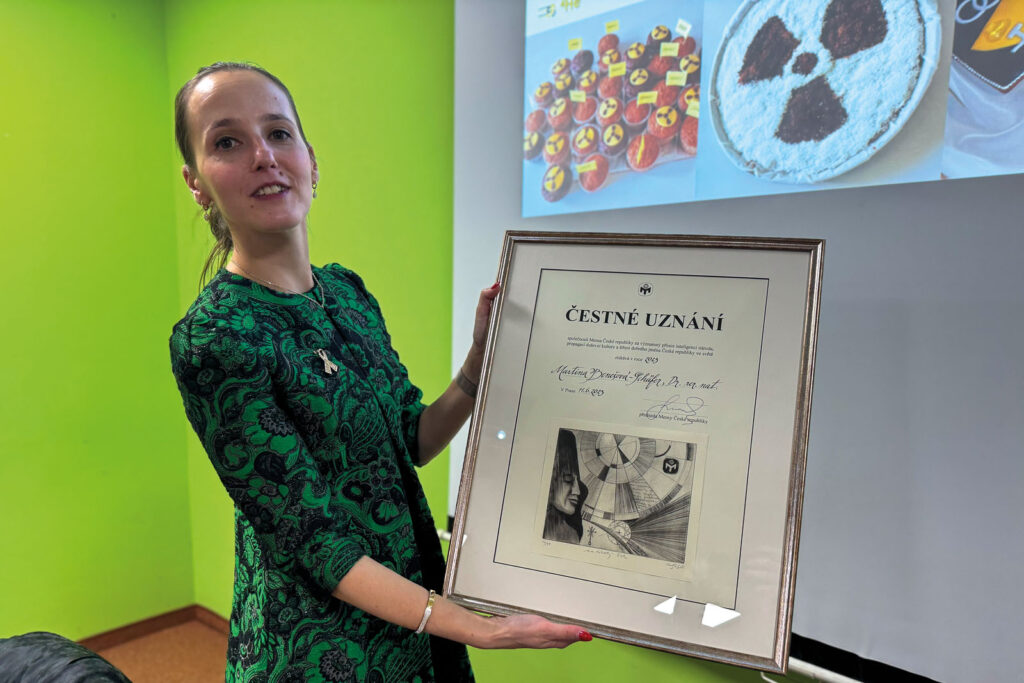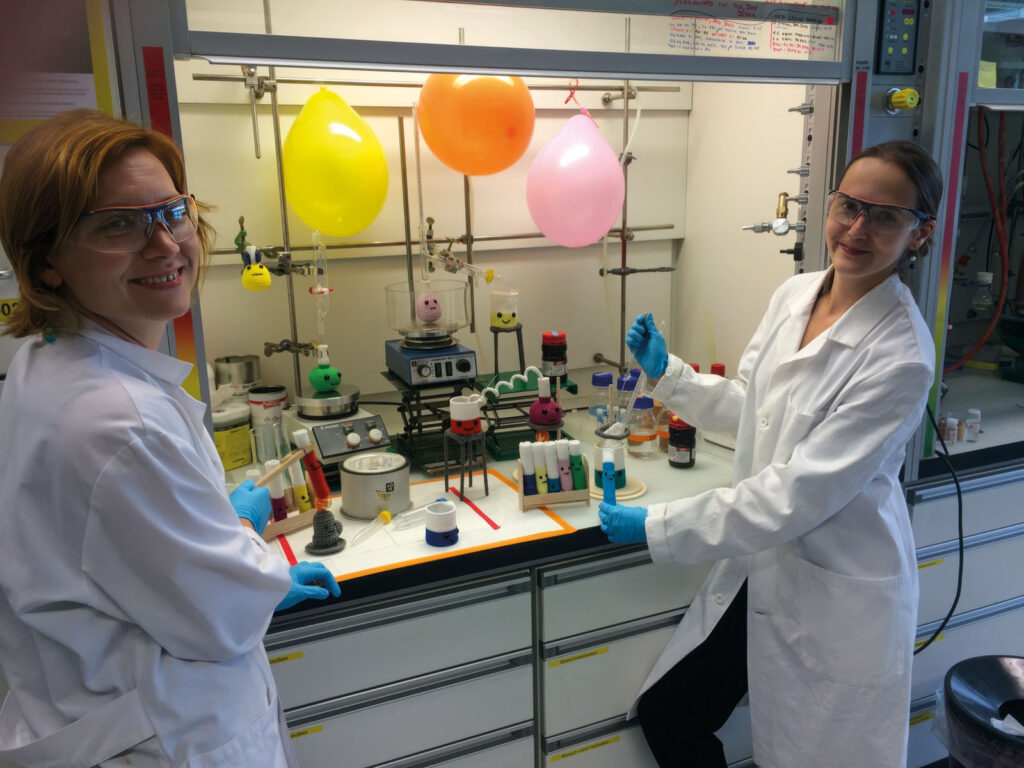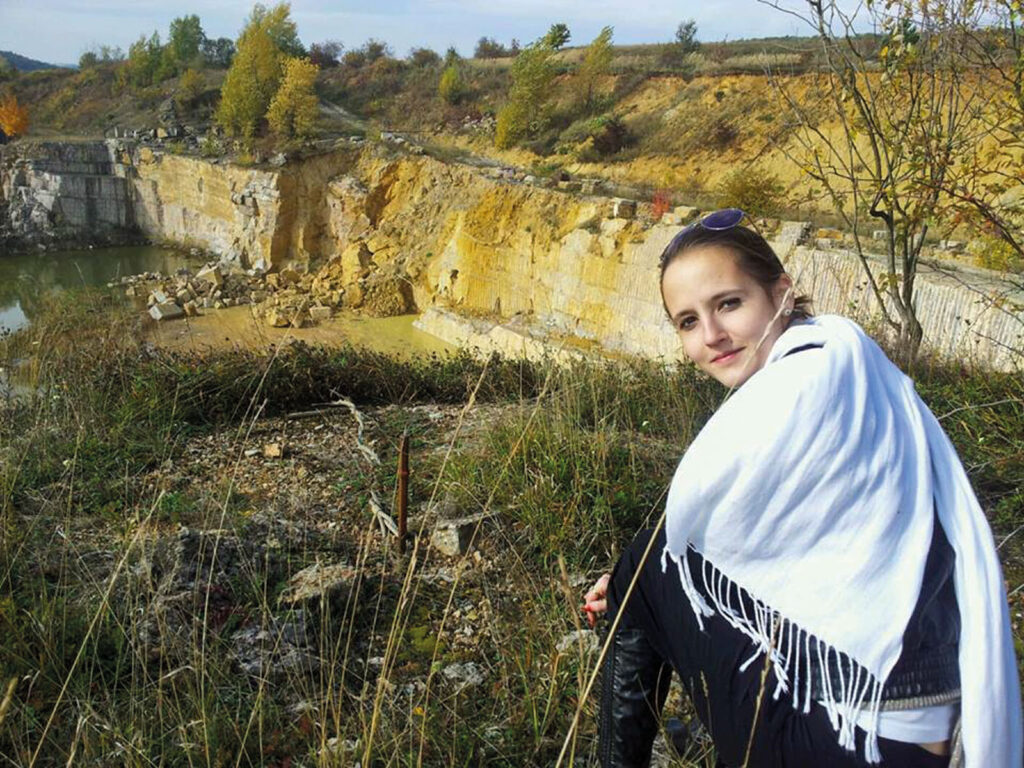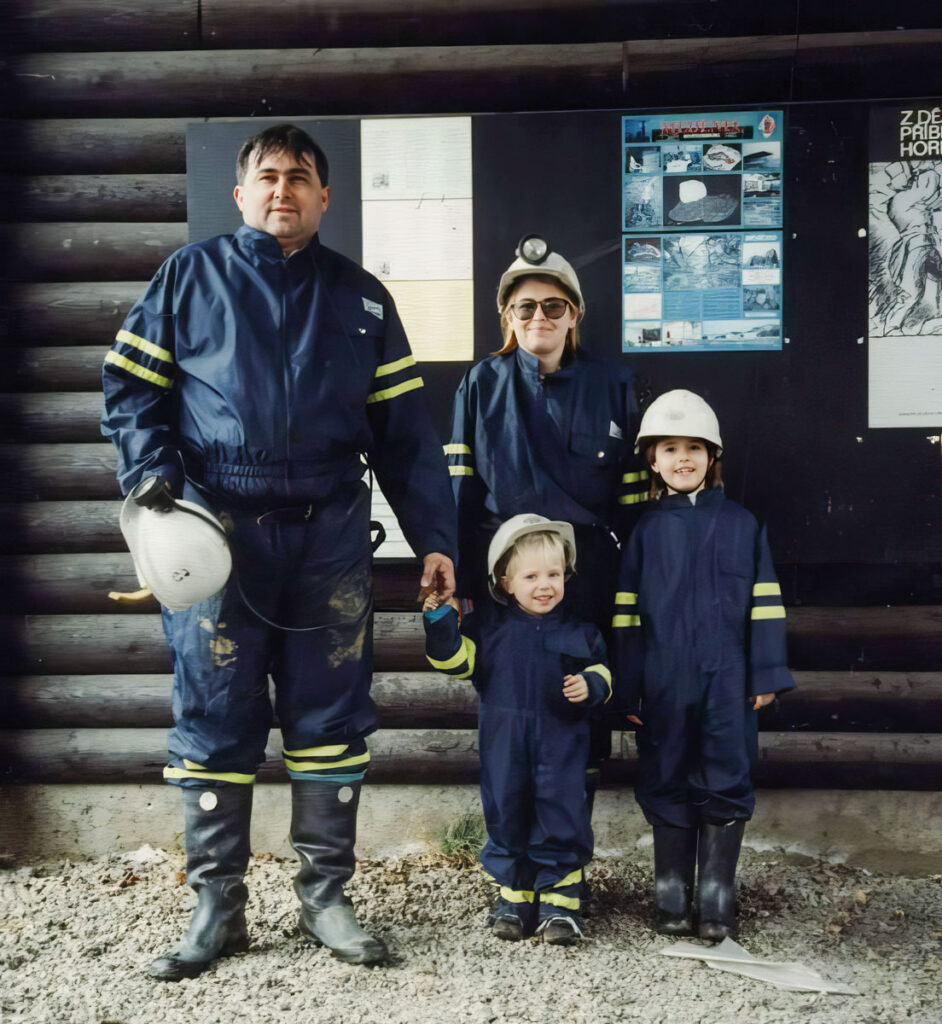
mensanthropist [ men-san-thruh-pist ] noun
a person, who actively participates in fulfilling one of Mensa’s objectives by fostering and utilizing intelligence for the benefit of humanity
This time I spoke with Martina Benešová-Schäfer, a nuclear chemist living in Germany, laureate of the Mensa Czechia Honorary Recognition for 2023. Martina was born in Ostrava, studied at Charles University in Prague, dedicated her doctoral thesis to Ozzy Osbourne, co-developed a groundbreaking prostate cancer drug in Germany at the age of 26, and spreads awareness of the positive aspects of radioactivity among the young and elderly across the whole Europe. What else did she tell me about herself and her work? Read on…
Martina, had you ever heard of the Mensa Czechia Honorary Recognition before you were contacted about receiving it? Or was it a completely new thing for you?
To be honest, I had some awareness through social media, but without them, I probably wouldn’t have known that any honorary recognition was being awarded. I encountered Mensa more as a child when they published various interesting puzzles and the like. I came across that, but only from a distance and indirectly. At school, we did some IQ test, but I don’t think it was an official Mensa test.
Receiving it is, of course, a great honor and privilege for me. However, when I told my family and colleagues that Mensa was giving me an award, they asked if it was in the canteen. Even some young academics thought Mensa was a canteen. [laughs]
You work in a German team. Does that mean that in German-speaking countries, the term „mensa“ is also used for a university canteen?
Indeed, the term „Mensa“ with an „s“ is used. [In Czechia the canteen is called menza…]
What do you think about Mensa as an organization?
What I like most about Mensa is that it connects people with a particular interest or taste in a specific area. I was thrilled that it supports gifted youth because youth is our future, and it’s very important that young talented people get as much support as they can. The most important thing is to support young people who want to continue their education, who are passionate, who are interested in learning and discovering new things.
You’re also not far from supporting children yourself. You’ve participated in scientific summer camps for kids. When was that, and what did this activity involve?
It started at the beginning of my university studies and continues to this day. Recently, the frequency of various days for children has increased because I mostly organize my time myself, so I try to give more space to these activities. These are mostly camps or courses in chemistry, biology, and physics. The vast majority of these courses deal with radioactivity, especially its significance, including the positive aspects. This is probably one of the most important private and professional battles for me — to somehow convey the good side of radioactivity to the general public because the bad side is mostly known.
For me, it’s important that people can form their own opinions from the other side as well. For example, in lectures for seniors, my explanations of what radioactivity is, that it’s all around us, and that we ourselves are also radioactive, have a calming effect, showing that it’s not just a threat. The beauty lies in shaping children and adolescents who are still relatively malleable while also alleviating the fear of unknown among seniors who wouldn’t otherwise get this information except from negatively biased media.


Radioactivity has been a part of your life since childhood. When did you first encounter it?
I don’t remember exactly because my dad took us to various locations when we were very young. Around the age of eight, I realized that my favorite rocks and minerals were the beautifully colored ones—yellow, green, red. When my dad explained to me that they glowed, I couldn’t grasp it. How could they glow? I couldn’t see or feel anything. But with the help of various radiation detectors, he showed me how amazing they were. And I was very fascinated by that.
Most people probably think of a Geiger counter when it comes to measuring radioactivity. Was that one of the devices your dad had?
My dad had plenty of them at home, mostly old ones. They were these heavy beasts that you had to handle carefully, or they would break. During my studies, I encountered various types of detectors, and I practically use them all the time at work. Today, for instance, I worked in a controlled area for a long time, and there I have five different ones at my disposal, three of which hang on my body.
Do you ever fear radioactivity, especially when you come into contact with higher intensities?
You must have respect for radioactivity, but not fear. That has been with me since the beginning of my studies. You have to think, be quick, and try to work in a way that minimizes risks. But fear only leads to mistakes and problems. Personally, fascination helps me overcome fear. But of course, I have great respect.
What do you think about activities like tours to Chernobyl? Have you ever been there?
I’ve always wanted to visit Chernobyl, mainly to see if the images from photographs match reality, because firsthand experience is often different. The smell, the feeling, you can’t convey that. Everyone has to experience it themselves. Unfortunately, due to the conflict between Ukraine and Russia, that probably won’t be possible for a long time, which I’m very sorry about.
However, my wish to visit Chernobyl is probably a bit different from most others. For me, it’s primarily gratitude for the level of radiation protection we have, how thoroughly developed the procedures for our work are. The Chernobyl disaster occurred mainly because the rules weren’t respected, and the operators didn’t fully understand what could happen.
Radioactivity has fascinated humanity since Madame Curie discovered it. It has even made its way into many American comics. But I was struck by a documentary about Chernobyl, where it was mentioned that several of the most affected people might have survived to this day. What do you think about how the human body sometimes adapts to extremely harsh conditions?
I have to say, Curie was also an amazing woman because it was found that the doses of radioactivity she was exposed to would not have been survivable by a normal, untrained individual. It is possible to develop resistance to radioactivity. Some individuals are more resistant than others, and for example, bats can tolerate much more radioactivity than humans, while goats can’t handle much at all. I’m not sure if you’ve heard of the Radium Girls — they were workers in the United States in the 1920s who painted watch dials with radioactive paint. They licked the brushes while working, and then their lower jaws would fall out, and so on. Even more fascinating is the dose of radioactivity that cancer patients undergoing treatment can endure. It’s all about risk and probability, and that’s how it should be viewed. There are many different factors at play. The discovery of radioactivity is relatively recent, and nuclear medicine was not officially recognized as a medical field until the 1970s, so we are still in the early stages.
One must focus on how much force should be used to crack a nut—whether to go straight for the sledgehammer or not. I mainly focus on the terminal stages of various types of cancer, so I believe it’s best to go straight for the sledgehammer.
Martina Benešová-schäfer
What was your path to what you do?
At first, it looked like I would continue studying geology or mineralogy like my dad and brother. But when I was deciding where to apply after high school, I thought it would be good to take a risk, learn something new, and take on a bit of a challenge. I already knew mineralogy and geology; they will always be my hobby. So, I initially chose general chemistry for my bachelor’s. And when I found out that we had nuclear chemistry as a follow-up master’s program, I knew that was exactly it.
How does Ozzy Osbourne fit into all this?
Ozzy Osbourne is my resilience. [laughs] My dad played a role there too. He had a big amplifier and played us various music. As a little girl, I liked the album Ozzmosis the most, and Ozzy has accompanied me from childhood through studies to work, which, of course, continues to this day. During my doctoral studies, he helped me regenerate and gain the strength to keep going, so I dedicated my doctoral thesis to Ozzy. The topic of that work was the development, design, and synthesis of ligands that can be used for the diagnosis and therapy of prostate cancer.
In a lecture in Prague, you mentioned that your favorite radionuclides are alpha emitters. What attracted you to them?
What I like most about them is that they are practically the most powerful radionuclides that can be used in patient therapy. So they are truly bombs. Although it doesn’t sound entirely positive, especially in medicine. The incredible power of this type of radionuclide is one of the main reasons I believe in them and why my research group focuses on developing new radiopharmaceuticals with them for other types of cancer. One must focus on how much force should be used to crack a nut—whether to go straight for the sledgehammer or not. I mainly focus on the terminal stages of various types of cancer, so I believe it’s best to go straight for the sledgehammer.
How long do you think it will take before this approach is applied in medicine? Usually, the less effective methods are tried first, and only then are the more effective ones allowed, often when it’s too late.
That’s true. But it also depends on how it’s balanced because when we go with maximum force, we naturally risk certain side effects. That’s why it’s very important to first understand the full functionality of these alpha emitters before we start using them routinely. Another limitation is that very few of these alpha emitters are produced worldwide. Moreover, the largest supply of really amazing pure actinium, which is one of these alpha emitters and comes from nuclear bomb tests, comes from Russia. Since the conflict in Ukraine began, this alpha emitter has, of course, no longer been imported into Europe, which has greatly affected the potential treatment of various cancer patients. That’s a connection I had never realized before.



People say that you invented that drug. But then there are people who say: „She didn’t invent it; the team invented it, and she just presents it publicly.“ So how does team research actually work?
It’s impossible without a team, and anyone who says otherwise, hats off to them. For example, our focus is extremely interdisciplinary, requiring specialists from various fields of chemistry, radiation chemistry, physics, biology, medicine. Part of the development was on my side; it was also my doctoral work, so I more or less decided the direction of the project. The structure of the drug itself came from my head, but, for example, we would never have been able to carry out the biological and clinical application without cooperative partners.
How much of the research is about receiving a specific task to create something and simply finding ways to achieve it, and how much happens randomly, as we know from the story of the discovery of penicillin?
Being in the right place at the right time with the right topic and a good dose of luck helps a lot. But, of course, without work, without interesting ideas, and without the ability to conduct various experiments, many scientific fields wouldn’t progress. Science is 90% failure. As my former supervisor used to say, „Try again, better and more joyfully.“ It’s important to realize that we’re not trying to force nature to behave the way we need it to but rather understand how nature behaves and then use that. The great art of science is also understanding when it’s time to stop and abandon something, even if it cost a lot of time, effort, and money, and start focusing on something that might make more sense.
But the odds are still better today than they were in alchemy, right?
The knowledge we have now is vast. And the more we know, the more we realize how much we don’t know. We have many supportive and scientific platforms that help; I can use high-throughput screening, have a computer model how my drugs should look, but I still stick to a conservative approach. For example, „This is an interesting building block; this is how it might work.“ This is how the previous drug was developed; it didn’t have any high-throughput or prediction; it was purely a gut feeling that this is what we should try. I believe that should remain in science.
Did I understand your creation correctly, if I try to describe it in layman’s terms, as a substance that acts as a sort of smart casing around the radionuclide, a smart messenger that knows where to go and where to attach?
More or less, yes, the drug consists of practically three most important parts. One of them is the vector that specifically targets the cancer cells. Then there’s a linker that connects the vector to something. And that something is practically the cage that beautifully holds the radionuclide; I often tell children it’s a backpack that carries the radioactivity and stays attached to the vector through the linker. So it gets where it needs to go, and only there does it cause mischief.
As a child, I saw a film that depicted a science fiction view of the future of medicine using nanobots, but you’ve actually gone a step further, where it’s no longer at the scale of nanotechnology but almost individual atoms. That’s simply fascinating.
Yes, radionuclides are so powerful that a size in femtometers or ångströms, even including the casing, is more than sufficient. The amount we usually apply for therapy, for example, for animals, is in the picogram range, so we are really significantly below the nanoscale.
What is the biggest obstacle or hindrance in your work?
Nature itself. [laughs] It often doesn’t cooperate. In the past, I would probably have said fundraising—it’s very challenging and takes a lot of time. Politics is very important in science, and that doesn’t exactly play to my strengths. But in reality, it will always be nature that is the most limiting factor.
I heard you have a quote displayed in your office: „Always be yourself, unless you can be Madame Curie, then be Madame Curie.“ Do you have any other personal role models?
Lise Meitner, for sure—a very interesting scientist with a very difficult fate. Among scientists, probably these two the most; they influenced me the most, and I adore their biographies. Sometimes I ask myself, „What would Curie do?“
Do you ever get tired of science?
Of course! [laughs] That’s not something you say these days, but very, very regularly, and thank God.


How do you relax?
I listen to Ozzy, of course. But what helps me the most, apart from my husband and our Chihuahua, is driving. The longer, the better. Because it requires full concentration, and I can’t think about the various things that normally pop into my head even when I’m resting, it brings me back to normal in an amazing way.
What about other means of transport, would you like to fly in a fighter jet for instance?
I definitely would. I’d love to drive a tank. I like tractors and various bulldozers and the like, anything heavy-duty that smells of gasoline or diesel fascinates me.
Does your Chihuahua travel with you?
Not on work trips, but any vacation has to be Chihuahua-friendly. That’s the most important thing for us. The Chihuahua has beautifully united us in that after 12 hours, you say, it’s nice to go home. For us, it was the first important step toward work-life balance. Someone who depends on us and who is looking forward to us coming home. For me personally, she has become something much more than just a part of the family. Her name is Stevie; we named her after Stevie Nicks from Fleetwood Mac.
In addition to practicing science, you also work on popularizing it. How many lectures do you give in a year?
Of course, there are months when there are fewer, like the winter ones. But I’d say definitely around forty to fifty a year. It’s not much, but since they’re in different parts of Europe, it takes a relatively long time.
Do you manage to read books?
Very rarely. Before bed. [laughs] It’s always those fifteen minutes when I say, „Now I’ll read something to fall asleep,“ and then I get hit in the face with the book, and that’s the end.
Do you have a favorite author?
Mika Waltari, William Styron, Samuel Shem, Günter Grass. There are definitely a few I’d find.
What is the main purpose of science for you?
Answering questions and, most importantly, finding new ones. Understanding how nature works, how we work, how the universe works, what we still don’t know, what we still don’t understand. Finding answers is a common response, but for me, it’s primarily about finding the questions we haven’t thought of yet.
Do you think there are more intelligent beings than humans?
Definitely, otherwise, it would be a waste of space. One of my favorite movies is Contact with Jodie Foster. That idea was in it, and when I think about the size of the universe and statistics, I believe we’re definitely not alone and definitely not at the pinnacle of evolution.
What would you most like to see happen in science or intelligence, ideally during your lifetime?
I’m quite worried about the new generation. In various semester papers or bachelor theses, I encounter the fact that with all this technology, it’s very difficult to think and connect things on your own. Personally, I would like to see the core of science preserved, which is knowing something, connecting that knowledge, discovering something based on it, and pushing it further. I feel that in this regard, science is currently going backward, that in the future, we’ll be clicking: Am I a robot? Am I not a robot? I have to ask artificial intelligence what I should answer… I would really like to see individuality remain in science.
What should Mensa members do with their intelligence to not waste it?
They should definitely get burned a few times in life. I think that’s part of it all. It strengthens the spirit and motivation. Young people are too concerned with what others think. Of course, it’s important to be part of a certain group, but it’s always important to live, explore, and work exactly as it suits you, and all those secondary influences should really be secondary.
You mentioned that you’re also looking for students who would like to join your team. What kind of people have a chance to be interested, and what should they do?
Contact me via email at m.benesova@dkfz-heidelberg.de. After the lecture for Mensa, I already have two new candidates, which is great. It’s important that the individual is willing to leave the Czech Republic because working and studying in a foreign language in a foreign country isn’t easy. It has many beauties and new experiences, but this must be clear from the beginning. Age is also important—you can only work with radioactivity from the age of sixteen and only if it’s part of your studies. We’re mainly looking for individuals interested in physics, biology, chemistry, or IT.
When is the best time?
I’d say in the fourth year of high school, sometime before graduation, but it can be done later as well. I would recommend students to try a few shorter internships so that they know exactly what their cup of tea is and which direction they should take in their studies because experience is untransferable, and everyone has to experience it themselves to make the right decision. And the sooner, the better.



